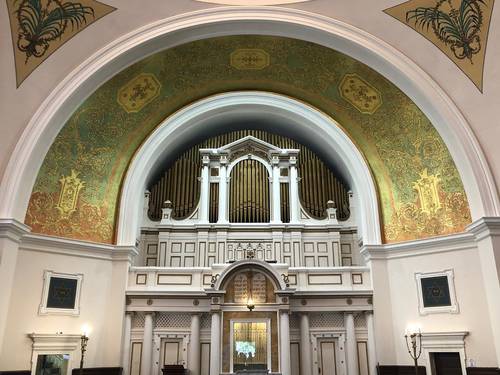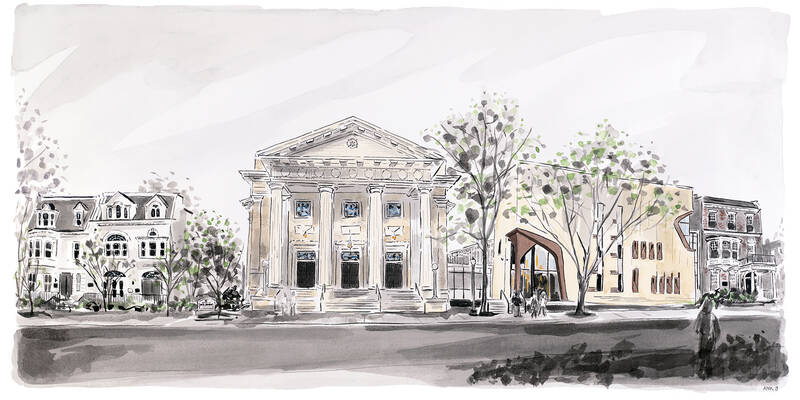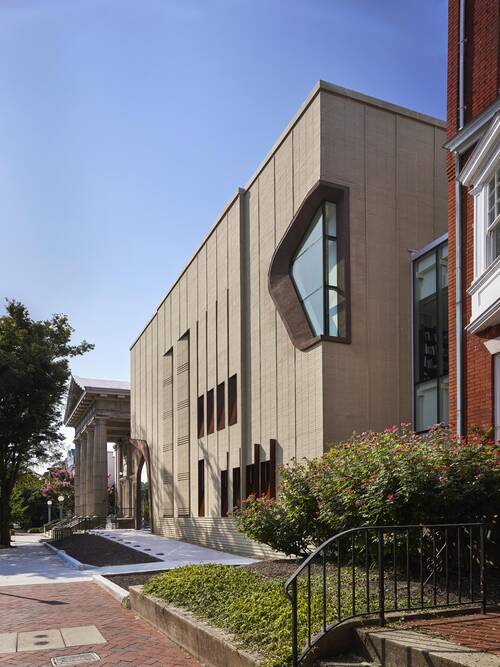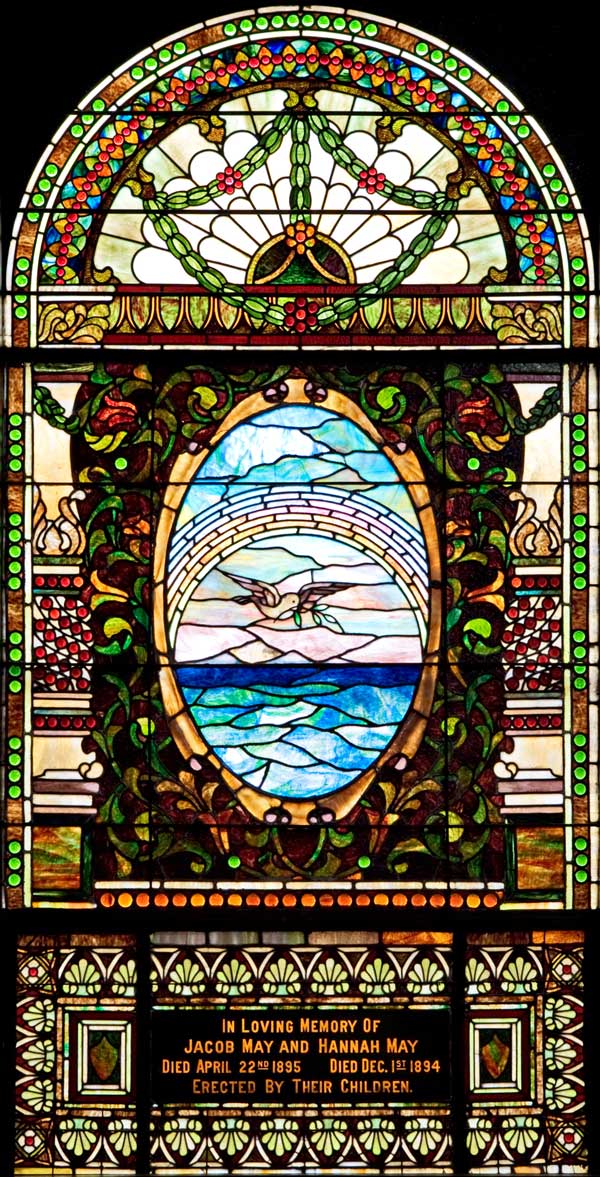
The word synagogue derives from the Greek word “synagein,” which means “to bring together.” It is an apt name for a structure that serves religious as well as social functions. Today Beth Ahabah is a vibrant congregation, worshiping in the Reform tradition and maintaining their religious beliefs yet wholly participating in the lives of their city, state and nation.

THE SANCTUARY
The Neo-Classical-style sanctuary is most noted for its proscenium arch. The arch still sports the elaborate painting given to it in 1913 after the Ladies’ Auxiliary had raised sufficient funds to give the previously austere sanctuary “the inspired touch of the artist.” The Ner Tamid or Eternal Light symbolizes God’s presence and hangs in front of the Ten Commandments at the head of the sanctuary. Original to the 1904 building, its use of the then new electric light bulb was an innovation in its day. The prominent placement of the pulpit and ark at the same end of the sanctuary, coupled with the magnificent original pipe organ, is typical of the “Americanized Judaism” preferred by Reform congregations of the day. The impressive pipe organ consists of over 2,000 pipes, ranging in size from 6 inches to 16 feet is no longer functional.
In 2021, the Branch Museum of Architecture and Design featured Beth Ahabah in a webinar series. Part I of the webinar explored details of the Beth Ahabah synagogue over time, including the sanctuary windows, proscenium arch, and dome ceiling, as well as highlighting restoration efforts over 150 years, showcasing how local preservationists and craftspeople repair and restore. Part II of the webinar explored the major and architectural award-winning 2018 update to the Beth Ahabah Campus, including critical design and construction stages from pre-design to building permitting and construction. The discussion included the challenges of preserving distinctive historical character in tandem with a tedious design review process. Click here to watch the webinar and for more information!
Beth Ahabah Campus Update


(art by Peyton Millikan)
In 2018, a series of additions and adaptations of the Beth Ahabah campus were completed. The new facade and structure, designed by Shinberg-Levinas, is a visual bridge between historic and modern, tying together three buildings built in different time periods, seen in the artwork above (from left to right): the Sanctuary building (dedicated in 1904); the Barbara and William B. Thalhimer, Jr. Religious School Building (dedicated in 1957); and the Joel House (from the early 1900s, donated later to the congregation). The artwork above also includes the Beth Ahabah Museum and Archives on the far-left.
The design of the new facade incorporates several Jewish symbols:
• The new main entrance to the Beth Ahabah Campus is framed by a two-sided arch representing the Hebrew letters chet and yud spelling chai (life).
• The 2 tall thin windows in the new facade split into 5 parts, which represent the Ten Commandments.
• The 8 smaller windows near a 9th larger window represent a chanukiah (Chanukah menorah).
This new structure has won multiple design awards, including:
• Golden Hammer Award in 2019 for Best Placemaking. Click here for more information.
• AIA Potomac Call Excellence in Design 2021 Honor Award/Gold Award for Best in Show - Non-Residential. Click here for more information.
• AIA Northern Virginia Design Awards 2021 Award of Merit in Institutional Architecture. Click here for more information.

STAINED GLASS
 We are particularly proud of the 29 beautiful stained glass windows that adorn our synagogue’s main Sanctuary. Many commemorate important congregants and include such images as the Eternal Light, the Burning Bush, the Garden of Eden, and the House of the Lord. Most notable is a window by Louis Comfort Tiffany on the building’s east wall. This striking window, depicting Mount Sinai at the moment the Ten Commandments were granted to Moses, was commissioned in 1923 by Fannie Mitteldorfer Schwab in memory of her parents, Ellis and Babette Mitteldorfer. Ellis Mitteldorfer was the son of Moses Mitteldorfer, one of the first presidents of Beth Ahabah. Tiffany’s signature is located in the lower right hand corner.
We are particularly proud of the 29 beautiful stained glass windows that adorn our synagogue’s main Sanctuary. Many commemorate important congregants and include such images as the Eternal Light, the Burning Bush, the Garden of Eden, and the House of the Lord. Most notable is a window by Louis Comfort Tiffany on the building’s east wall. This striking window, depicting Mount Sinai at the moment the Ten Commandments were granted to Moses, was commissioned in 1923 by Fannie Mitteldorfer Schwab in memory of her parents, Ellis and Babette Mitteldorfer. Ellis Mitteldorfer was the son of Moses Mitteldorfer, one of the first presidents of Beth Ahabah. Tiffany’s signature is located in the lower right hand corner.
OTHER MAJOR WINDOWS
The sanctuary’s nine other major windows are presented as they appear moving clockwise from the northeast corner of the sanctuary’s lower level.
 Dedicated to the memory of Levi (1833-1909) and Henrietta (1831-1887) Hexter and erected by their children. “I Will Lift Mine Eyes Unto The Hills From Whence Cometh My Help” Psalms 121:1. Levi Hexter was President of Congregation Beth Israel at the time of its incorporation into Congregation Beth Ahabah.
Dedicated to the memory of Levi (1833-1909) and Henrietta (1831-1887) Hexter and erected by their children. “I Will Lift Mine Eyes Unto The Hills From Whence Cometh My Help” Psalms 121:1. Levi Hexter was President of Congregation Beth Israel at the time of its incorporation into Congregation Beth Ahabah.
 The first window installed in the current sanctuary is dedicated to the first spiritual leader of Beth Ahabah, the Rev. Maximilian J. Michelbacher. The window depicts the Ner Tamid, or Eternal Light, symbolizing the illumination of spirit and education that emanated from Rev. Michelbacher and filled the hearts and minds of all who knew him. “Thy word is a lamp unto my feet and a lamp unto my path,” Psalm 119:105.
The first window installed in the current sanctuary is dedicated to the first spiritual leader of Beth Ahabah, the Rev. Maximilian J. Michelbacher. The window depicts the Ner Tamid, or Eternal Light, symbolizing the illumination of spirit and education that emanated from Rev. Michelbacher and filled the hearts and minds of all who knew him. “Thy word is a lamp unto my feet and a lamp unto my path,” Psalm 119:105.
 This window, the last installed in the main sanctuary, is dedicated to the memory of Dr. Edward N. Calisch, Beth Ahabah’s rabbi from 1891 to 1946. Designed by his son Harold, it depicts the Outer portion of the Temple in Jerusalem as seen from within. The verse “I shall dwell in the House of the Lord Forever” is from the 23rd Psalm, a favorite of Dr. Calisch. The window, erected by the congregation, is composed of glass especially made to catch the light streaming from the west.
This window, the last installed in the main sanctuary, is dedicated to the memory of Dr. Edward N. Calisch, Beth Ahabah’s rabbi from 1891 to 1946. Designed by his son Harold, it depicts the Outer portion of the Temple in Jerusalem as seen from within. The verse “I shall dwell in the House of the Lord Forever” is from the 23rd Psalm, a favorite of Dr. Calisch. The window, erected by the congregation, is composed of glass especially made to catch the light streaming from the west.
CAROLE AND MARCUS WEINSTEIN EDUCATION CENTER
Dedicated in September 2021, the Carole and Marcus Weinstein Education Center at Beth Ahabah is a flexible classroom and meeting space for both virtual and in-person programs. Containing state-of-the-art equipment allowing hybrid meetings and classes, this room is both a functional beautiful addition to our campus.
Parsha Posters by Hillel Smith

The Weinstein Education Center showcases an art installation, also generously donated by Carole and Marcus Weinstein, of the entire collection of Parsha Posters created by Washington, D.C. artist Hillel Smith. A nod to his love of typography, Hillel integrated the Hebrew name of the weekly parsha (Torah portion) into each design. Some names are easy to find and read, while others are intentionally abstracted or hidden for the viewer to decipher. The poster with the current week’s Torah portion is rotated into the Lobby every week, along with a summary and explanation of the portion.
To read Hillel's commentary on each poster, click HERE.












